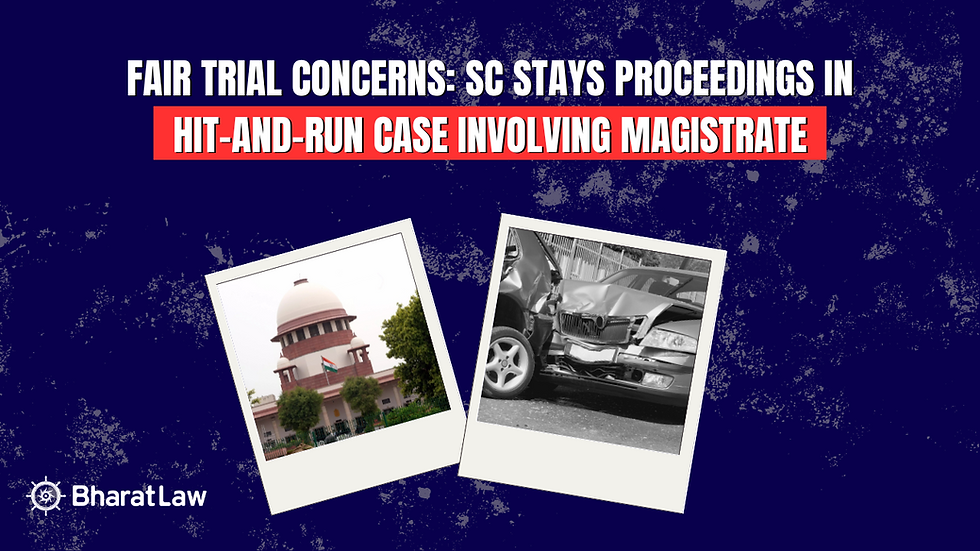Negation of Bail is the Rule, Grant is the Exception– Key Takeaways from the Supreme Court’s Ruling in NCB vs. Kashif
- Chintan Shah

- Dec 25, 2024
- 3 min read
Summary of the Judgment
Case Name: Narcotics Control Bureau vs. Kashif
Case Number: Criminal Appeal No. 5544 of 2024
Date of Judgment: 20th December 2024
Judges: Hon’ble Justice Bela M. Trivedi, Hon’ble Justice Satish Chandra Sharma
Advocates:
Mr. Tushar Mehta (Solicitor General of India) for the appellant, Mr. Akshay Bhandari for the respondent
Acts and Sections Involved: Section 8, Section 22(c), Section 23(c), Section 29, Section 37, and Section 52A of the Narcotic Drugs and Psychotropic Substances Act, 1985
Cited Judgments:
Hira Singh and Another vs. Union of India and Another (2020) 20 SCC 272
State of M.P. vs. Kajad (2001) 7 SCC 673
NCB vs. Mohit Aggarwal (2022) 18 SCC 374
Union of India vs. Mohanlal (2016) 3 SCC 379
Introduction
The judgment delivered by the Hon’ble Supreme Court in the case of Narcotics Control Bureau vs. Kashif addresses critical procedural and substantive aspects of the Narcotic Drugs and Psychotropic Substances Act, 1985 (NDPS Act). This analysis explores the court’s interpretation of Section 52A, the implications of procedural compliance on the grant of bail, and the broader objectives of the NDPS Act.
Background of the Case
The appeal arose from an order by the High Court of Delhi, granting bail to the respondent, Kashif, based on alleged procedural non-compliance with Section 52A of the NDPS Act. The Narcotics Control Bureau (NCB) contested this decision, arguing that the High Court failed to consider mandatory provisions under Section 37 and misinterpreted Section 52A.
Key Legal Issues
Scope and Interpretation of Section 52A:The court examined whether delayed compliance with Section 52A—which pertains to the disposal of seized narcotic substances—invalidates prosecution or entitles an accused to bail.
Mandatory Nature of Section 37:Section 37 stipulates stringent conditions for granting bail in cases involving commercial quantities of narcotics. The Hon’ble Court scrutinised the High Court’s failure to apply these provisions.
Relevance of Procedural Compliance:The judgment considered whether procedural lapses in complying with Section 52A constitute illegality or mere irregularity.
Court’s Observations
1. Section 52A and Procedural Compliance
The court highlighted that Section 52A was introduced to address practical challenges associated with the storage and disposal of seized narcotics, given their hazardous nature. The provision requires:
Preparation of an inventory of seized substances;
Certification of the inventory by a Magistrate;
Drawing of representative samples for trial purposes.
Hon’ble Justice Bela M. Trivedi noted:
“Any deviation or delay in making the application under sub-section (2) by the concerned officer to the Magistrate or the delay on the part of the Magistrate in deciding such application could at the most be termed as an irregularity and not an illegality which would nullify or vitiate the entire case of the prosecution.”
This interpretation ensures that procedural lapses do not overshadow substantive evidence of guilt.
2. Mandatory Nature of Section 37
Section 37 creates a presumption against granting bail in NDPS cases unless two cumulative conditions are met:
The court must have reasonable grounds to believe the accused is not guilty.
The accused is unlikely to commit any offence while on bail.
The judgment reiterated the importance of adhering to this statutory mandate:
“Negation of bail is the rule, and its grant is an exception. The recording of findings as mandated in Section 37 is a sine qua non for granting bail to the accused involved in offences under the NDPS Act.”
3. Objectives of the NDPS Act
Referring to the judgment in Hira Singh, the court emphasised the Act’s objectives:
“The NDPS Act is a special law intended to combat the menace of drug trafficking, which is a crime against society. It requires stringent interpretation to fulfil its purpose of deterring illicit drug trade.”
Critical Evaluation of the High Court’s Order
The Hon’ble Supreme Court found the High Court’s reasoning flawed on multiple grounds:
Failure to Apply Section 37:The High Court did not record the mandatory satisfaction required under Section 37 before granting bail.
Misinterpretation of Section 52A:The High Court’s focus on procedural delay in compliance with Section 52A was deemed misplaced. Procedural irregularities, unless prejudicial to the accused, cannot form the sole basis for bail.
Reliance on Non-Binding Precedents:The Supreme Court clarified that earlier decisions cited by the High Court—which involved specific factual contexts—did not establish a general principle that procedural lapses vitiate proceedings.
Conclusion
The Supreme Court’s decision reinforces the legislative intent behind the NDPS Act and underscores the importance of balancing procedural adherence with substantive justice. By remanding the matter for fresh consideration, the court ensured that procedural lapses do not undermine the prosecution’s case when evidence of guilt is otherwise compelling.
This judgment serves as a crucial precedent for:
Emphasising the mandatory nature of Section 37 in bail applications;
Interpreting procedural provisions like Section 52A in a manner consistent with the NDPS Act’s objectives;
Ensuring that technical lapses do not result in unwarranted acquittals or bail.



Comments